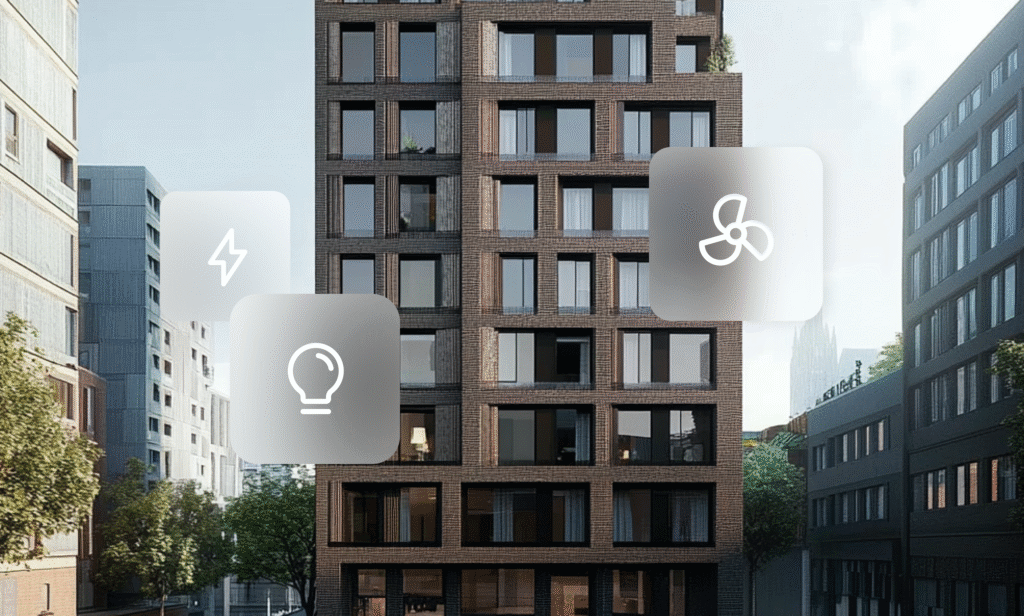

Building
The Guardian Building

Location
Detroit, MI, US

Solution
Unified Building Insights
Remote Command & Control
Equipment Performance Optimization
By KODE Team
On this page
Sign up to our newsletter
Subscribe to receive the latest blog posts to your inbox every week.
By subscribing you agree to with our Privacy Policy.
Guardian: A national historic landmark
The Guardian Building has seen many upgrades and retrofits over the last 90 years. The way people use the space has also changed, which places emphasis on the ability for the building systems to be flexible and adjustable over time.
Systems (i.e. HVAC, Lighting) in a building are often siloed from one another. This increases the difficulty of analyzing and comparing systems and prohibits the flow of data from one system to another. Property managers and building operators often struggle to manage multiple disparate systems from one location. The data that is often not shown, may impact the ability for the property to attract new tenants or reduce energy consumption.
Built in 1928, The Guardian Building is a National Historic Landmark. It is a timeless representation of creativity and achievement that has stood the test of time. It represents a past era enriched by people who believed in the success of Detroit and its diverse culture. As one of the most significant Art Deco skyscrapers in the world, KODE Labs and Green Building Automation felt a strong conviction to bring The Guardian Building into the 21st Century by future proofing it’s building systems.
With our partner, Green Building Automation, we have helped The Guardian Building leverage it’s building system data to optimize performance, reduce energy consumption, and enhance comfort.
The challenge
- The building was operated with four independent BAS systems. Most of these systems were proprietary or obsolete. Additionally, these systems did not communicate with one another, as such, the building’s BAS system was difficult to manage and operate.
- Building engineers had to be trained on how to use each system. Each BAS system is unique. Without the proper training, building engineers may find these systems difficult to operate. Additionally, training new employees to use these different systems is time consuming and can result in operational inefficiencies for the building.
- Building engineers had to log into each system separately while on site. Any issues or faults raised by the BAS system required engineers to log into the separate system manually to resolve the issue. Each BAS system had their own set of login credentials.
- There was no way to operate the building remotely or receive alarms. If something happened within the building, the engineers would receive an emergency call and had to go to the building physically to address the problem.
- There was no data on facility operations and energy usage. The building had no data on whether the building was operating efficiently.
The solution
- Integrated the existing BAS into an open and single smart building platform. The platform integrates easily with any building system and provides operators with a seamless interface to control all aspects of the building. Additionally, the platform is open and vendor agnostic, which means it can integrate with a variety of different system manufacturers.
- User-friendly BAS front end interface. This provided the building operators with an intuitive graphical user interface and simplified the training of new users to manage, maintain, and operate the building.
- Single web and mobile app-base application for remote access. Building engineers were provided remote access capabilities with a web enabled application. Building information and controls can be accessed securely from anywhere remotely, improving operations and efficiencies.
- Automatic scheduling and programming as required by the tenants. Tenants in commercial real estate often have different hours of operation. With the new platform, operators were now able to set up more equipment schedules for certain floors and rooms. The added scheduling flexibility allowed the operators to reduce the run-time of equipment, which over time, helped reduce energy consumption of the building.
- Reduced energy consumption. The platform’s flexibility allowed for the integration of energy metering data. This provided the operators with analytics regarding the building’s peak demand. Using machine learning, the platform leveraged the platform’s data to improve the energy efficiency of the building in real time by up to 30%. This data included peak energy demand, outdoor temperature, indoor air quality, and occupancy data.
Testimonial
The Guardian Building is a maze of BAS systems that do not communicate with each other. As building owners have changed and built outs have occurred upgrades were made, new systems were installed but only for the “new spaces”. This created a system that simply did not work from an operations perspective.
Green Building Automation and KODE Labs have changed all of that. They were able to take our four major systems and integrate them into a simple front end platform. Not only the BAS systems but also damper controls, pumps and the like. It has definitely been a game changer for the building engineers. As we move forward we are adding controls on other equipment throughout the building and integrating it into the new system. The Guardian Building engineers no longer have to go to the plant to check the temperature in any given space. The system can be accessed from their mobile device. Yes, we were behind the times and we knew it.
Green Building Automation helped us work with the DTE RCx program folks to further find ways to optimize our performance and utility consumption. We are looking forward to the next phase of this project.
Shannon M. Haag – Property Manager, Guardian Building




